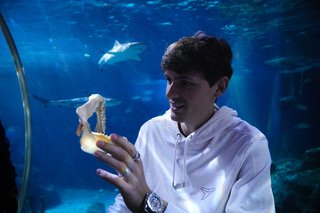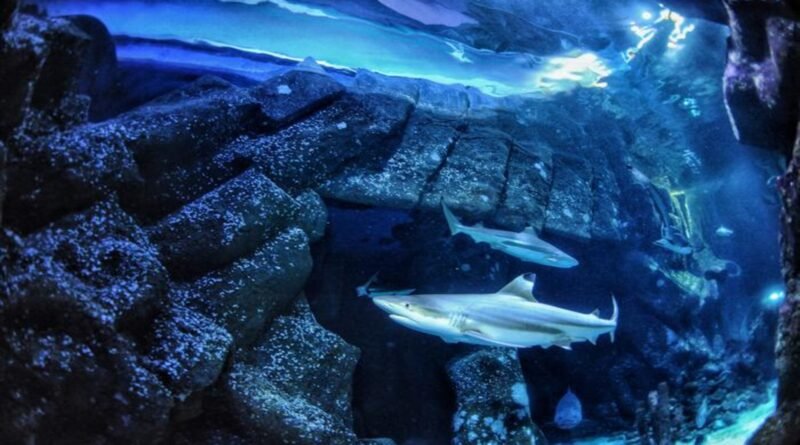Ocean Acidification Threatens Shark Bites
Numerous studies have shown that ocean acidification, caused by anthropogenic emissions of CO₂, will have a significant impact on various marine organisms. But what is the effect on the teeth of, say, a shark? The answer to this question was addressed in a study conducted by German scientists, who investigated the corrosive effects of acidification on the morphology of isolated shark teeth incubated for eight weeks at pH 7.3-the level expected for seawater in the year 2300.
It should be emphasized that this study was carried out on isolated teeth collected from captive individuals of Blacktip reef sharks at the Sea Life Oberhausen aquarium, and that no live animals were exposed to acidified conditions.
At present, the average pH of the world’s oceans is 8.1 and is expected to drop to 7.3 by 2300, making them nearly 10 times more acidic. This is why these two pH values were used in the study to examine the effects of more and less acidic water on the teeth of Blacktip reef sharks. Divers collected more than 600 discarded teeth from an aquarium housing the sharks. 16 teeth, those that were completely intact and undamaged, were used for the pH experiment, while 36 more teeth were used to measure the before and after circumference. Compared to the teeth incubated at pH 8.1, the teeth exposed to more acidic water were significantly more damaged. Using scanning electron microscopy (a technique that reveals, for example, the detailed three-dimensional structure of a sample’s surface), the researchers observed the corrosive effects of acidification on various dental structures.
The results show that ocean acidification will significantly affect the morphological features of teeth, including visible corrosion on the crown and degradation of root structures under low-pH conditions.

Maximilian Baum, who conducted the study, with a blacktip reef shark jaw. He found increased root corrosion and altered serration. Photograph: Roman Müller-Böhm
For Unknown Focus, first author of the study “Simulated ocean acidification affects shark tooth morphology, “ Maximilian Baum, a biologist at Heinrich Heine University Düsseldorf (HHU), answered a few questions.
“Even smaller pH changes, which we could reach much sooner than 2300, might already lead to measurable corrosion.”
As currently noted, the average pH of the world’s oceans is 8.1. In 2300, it is expected to drop to 7.3, making it almost 10 times more acidic than it currently is. How to avoid the attitude “It’s the year 2300… we have time”?
Maximilian Baum: In our experiment, teeth were only incubated for a few weeks, yet we already observed significant corrosion in the acidified group compared to controls. In reality, shark teeth often remain in use far longer than six weeks, especially in species that use multiple rows simultaneously. It’s also likely that even smaller pH changes, which we could reach much sooner than 2300, might already lead to measurable corrosion. This is something future studies should investigate more closely.
“Studying this in vivo would be a logical and important next step.”
The study only looked at discarded teeth of non-living mineralized tissue, which means repair processes that may happen in living organisms could not be considered. In addition, the study only focused on the chemical effects of ocean acidification on non-living tissue. Considering metabolic processes, regeneration, and the energetic costs of repairing teeth, could these effects be more pronounced in living tissue? This is an excellent starting point and lays a good foundation, so I’m curious, what would be the next step?
Maximilian Baum: The effects in living sharks could go in either direction. Teeth formed under acidic stress might be more fragile, but sharks could also respond physiologically by remineralizing or chemically stabilizing their teeth. However, this would likely require additional energy. Studying this in vivo would be a logical and important next step.
“There are high legal and ethical barriers to conducting experiments on live sharks in Europe.”
How easy is it for scientists in Europe to conduct this kind of research, and what could help you in the future?
Maximilian Baum: There are high legal and ethical barriers to conducting experiments on live sharks in Europe. In our case, our collaboration with SEA LIFE was extremely helpful, as it gave us access to animals kept under controlled conditions and allowed us to collect naturally shed teeth non-invasively.
“In our study, both sexes showed similar corrosion patterns, but it’s an interesting thought that damage to such specialized teeth could potentially impact not only hunting but also mating success.”
Are there possible differences in tooth resistance between male and female sharks?
Maximilian Baum: Shark dentition is highly specialized and diverse, even between males and females. In our Blacktip Reef Sharks, males had differently shaped upper jaw teeth with stronger hooks, used during mating to hold onto females. In our study, both sexes showed similar corrosion patterns, but it’s an interesting thought that damage to such specialized teeth could potentially impact not only hunting but also mating success.
“If sharks need to replace teeth more frequently while facing reduced mineral uptake, this could lead to increased energetic demands and reduced efficiency.”
Considering that sharks replace their teeth, this might seem like some sort of advantage, but the reality is that it’s actually very serious. Do you think changes are possible? For example, could young sharks be at risk in the future if nothing changes, meaning we could face a major problem?
Maximilian Baum: Tooth replacement may seem like an advantage, but producing new teeth depends on mineral availability, especially calcium and phosphate. These are harder to absorb under acidified conditions. If sharks need to replace teeth more frequently while facing reduced mineral uptake, this could lead to increased energetic demands and reduced efficiency. Over time, this may affect their ecological success, especially in early life stages.
Image: Blacktip Reef Shark at Sealife Oberhausen, where teeth used in the study were collected. Credit: Max Baum.


